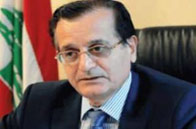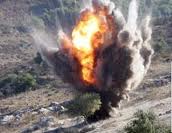May 25: Defeating “The Invincible Army”

By Amir Kanso
 As the sea waves fearfully broke by the shore, a gloomy echo filled the deep darkness of night...Weird flocks made their way through the sky, shaking the atmosphere with their shrieks. Many blocked their ears and turned their backs on the sea range... And they got ready to leave in that red evening... Those men were as solid as their land; their little weaponry and their belief constituted their legendary power...
As the sea waves fearfully broke by the shore, a gloomy echo filled the deep darkness of night...Weird flocks made their way through the sky, shaking the atmosphere with their shrieks. Many blocked their ears and turned their backs on the sea range... And they got ready to leave in that red evening... Those men were as solid as their land; their little weaponry and their belief constituted their legendary power...
Having met no barriers so far, the enemy thought it was the only legend on this earth...However; "the first bullets" in Khaldeh made the enemy begin to understand the limits of its power...
Right then, the story of the Islamic Resistance began, as Hizbullah Secretary General, His Eminence Sayyed Hassan Nasrallah, said on August 17, 1999, "We made this war begin with the first bullets in Khaldeh in 1982. We were perfectly aware of whom we were fighting and of the hard path we were taking..."
A new kind of war did begin and make the enemy certain that its power was a fake legend, and on May 24, 2000, this fake legend received the coup de grâce.
From June 6, 1982 through June 9, 1982, were only three days, but they were enough for the enemy to reach the doors of the capital Beirut, besiege it with fire, and have war aircraft raze its quarters and those of Beirut Southern Suburb. Full buildings were now ruins, and nothing but demolition and death were left behind this enemy. Fear filled hearts as the Zionist army progressed on land, in air, and in the sea. Indifferent to anything, this army surrounded and demolished cities and villages and slew citizens as it headed to the Capital Beirut... Nobody knew what exactly this enemy wanted, especially when the General in charge was Ariel Sharon, who had the passion of killing wherever he went.
Afterwards, everyone went on his way and returned in a few hours, armed and ready for the anticipated confrontation. Amid all this, some young men, who were united by their belief in their Lord, would gather in the mosques of Beirut Southern Suburb, reflecting on the urgent events and discussing the way to resist this invasion and to defend the poor quarters.
In fact, the term "the Believing Youths", which was current then, showed that those youths had taken the path of Imam Khomeini (May Allah Sanctify His Secret); together they abided by his call at that time, "Fight ("Israel") with your teeth and nails, and don't let it occupy your land."

On June 9, 1982, the Occupation forces arrived in Khaldeh after several attempts that had lasted for hours upon the violent confrontation of the Resistance... Hereupon, the Zionists depended upon their air and naval forces to cease every resistance with massive barrages. Then they commenced maneuvering audaciously, for they thought that they had dominated the battle field... Yet, news reached Ouzai Region the moment the "Israeli" forces arrived in Khaldeh.
As tens of armed youths stood close to the old mosque of Ouzai, a fighter and a group of believing young men stood there, and the fighter addressed the gathered youths, "The "Israelis" have arrived in Khaldeh. Now if we don't stop them and prevent them from progressing, then they'll make their way into Beirut..." Then the fighter asked them, "Who wants to fight this enemy?"
He stood in front of all of them, shouting, "Now the door to Heaven is open, so who does wish to support Imam Hussein (Peace be upon him) must go to Khaldeh, for Imam Hussein is there. And who seeks Heaven must accompany us through this confrontation."
Unlike what had been expected, only very few youths responded. Thus, a group of twelve young brothers (fighters) set off, whereby four of them had to stay by the bridge as the other eight headed forward.
The fighters proceeded until they reached an area by the old way to the South, where they could see the Zionist vehicles clearly as the vehicles progressed without being confronted; yet, a tank was damaged upon the earlier attempts of the previous fighters to encounter the Zionist drop before their withdrawal.
The fighters got posted in the alleys branching from the old way to the South, between "the Beach Club" and "Marroush Island Restaurant", where counter tanks and half-tracks were moving along and had taken certain posts.
Right after taking their positions, the fighters began launching their bullets and anti-shield projectiles "B-7", and the enemy started bombarding the fighters' posts.
Once this group firmly encountered the Zionist force, the close and far sites, the fire of which had been seized earlier by the "Israeli" raids, retained their activity, whereby the site members shot fire at the confrontation spot.
By the time the very few fighters finished the battle, the three Zionist tanks and a half-track in the confrontation spot had been destroyed, whereas only one half-track had escaped destruction.
As for the remaining members of the Zionist force that had intended to proceed with the drop, they withdrew to the sea again through a sea bridge after the confrontation, whereas the force that had been in the confrontation spot was totally exterminated.
Actually, the power, courage, and conduct with which the fighters encountered the "Israeli" forces in the battle field brought the other fighters, who had withdrawn from the area, back to their spirits of courage; hence, they came back to inquire about the confrontation incidents and to share the battle.
The remaining half-track had been shot with an Energa anti-tank rifle projectile (PEP) at the beginning of the battle, and it was damaged, for the military vehicles at that time could be damaged by such projectiles and destroyed and burned with the "B-7" projectiles. Unlike today, even the Merkava tanks could be destroyed with anti-tank projectiles at that time.
Although one of the brothers (fighters) was then wounded, he was preparing to shoot a "B-7" projectile at the half-track, so another fighter asked him to stop because the half-track was moving without shooting fire, what meant it suffered some kind of trouble.
As the half-track approached the fighters, they encompassed it and shot it with their bullets. As a result, it scared crewmen got off it, screaming. Then the fighters used firearms to engage with the enemy soldiers in a face-to-face combat. In the meantime, the tanks at the back of the battle field were burning, and so some of their crewmen were killed, whereas the others escaped the tanks to engage in the direct combat as their screams of fear could be heard in the distance.
The firearms combat lasted for a half-hour approximately, whereby the enemy soldiers were killed. A big number of the enemy soldiers' corpses bore bullets, and two other corpses remained in the half-track.
The fighters seized the half-track before gathering the corpses and placing them by the half-track. Things calmed down, and the fighters flowed from different directions reaching the battle field.
Some squadrons seized several corpses, and the Resistance fighters kept some others with them.
Furthermore, some reporters in the operation spot wanted to know who those fighters that had led this battle were, so a reporter asked a fighter, "Where do you come from?" And the fighter answered, "We're from Ouzai Region." Asked another question, the fighter declared, "We're the followers of Imam Khomeini - "the Khomeinis"..." In fact, the reporters found the name was strange upon hearing it for the first time.
Afterwards, preparations to tug the half-track commenced as it was not shot with the "B-7" projectiles and was still undestroyed. Therefore, one of the fighters set off to Ouzai Region to create a convenient atmosphere for receiving the half-track before the motorcade, which included it, moved there. Reaching Ouzai with a Zionist soldier's helmet, another's "Mag" pistol, and a third piece of weaponry, the fighter found people gathered at Al-Burj Curb .
.
At once, the fighter went through the crowd and in front of everybody, he stood on top of his car addressing the crowds, "These are the weapons and a helmet of the "Israelis" that "we're afraid of and do not dare fight them because they're strong!"" Throwing the firearms and the helmet on the ground, the fighter continued, "Their vehicles are now in Khaldeh, and in a while, you're going to see the pillage with your own eyes. We're going to pass the vehicles here, in front of you, so stay in this square so that you see what has happened to the "Israelis"..." Then the fighter returned to the battle spot, and the motorcade had already set off from Khaldeh Region.
It was a unique scene once the motorcade reached Ouzai, whereby none would see such scene through the years that were to follow, except for the time when the Islamic Resistance would expose the pillage it would seize from the Zionist enemy after the liberation of Southern Lebanon in 2000.
Absolutely, the will of the fighters, whether those in Khaldeh, the Faculty of Sciences, Beirut International Airport, Ouzai, Tayyouni, or Ghobeireh, created a barrier against the enemy's attempts to conquer Beirut Southern Suburb and its will... Not even the air-raids, which blazed the quarters of the Suburb, affected the determination of its people, whereby on February 6, 1984, they left their homes and fought the enemy agents, and on May 17, 1983, they rallied against the agreement of disgrace and humiliation (The May-17 Agreement with the enemy). Those people offered Martyr Muhammad Najdi, who signed with his blood that surrender to the enemy would never exist and that only the path of resistance achieves victory.
This path has been essentially led by brilliant martyrs and their successors, who are fighters that have left their poor neighborhoods and ghettos, looking forward to gaining victory or martyrdom.
Their fists have protected the Suburb and Lebanon. Thus, the Suburb has withstood the Occupation... And our country's land has been liberated. Allegiant to their vow, they shall sustain the path.
"Alintiqad" Reminiscence - May 24, 2002



